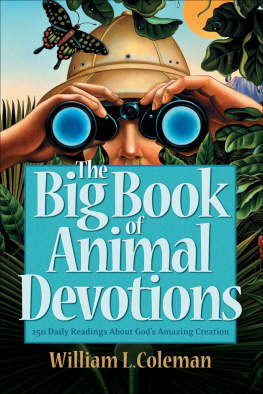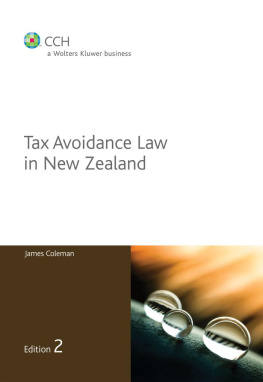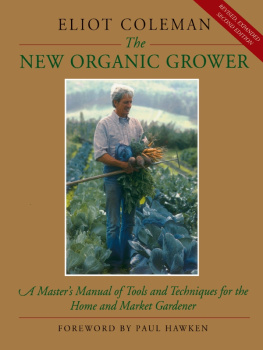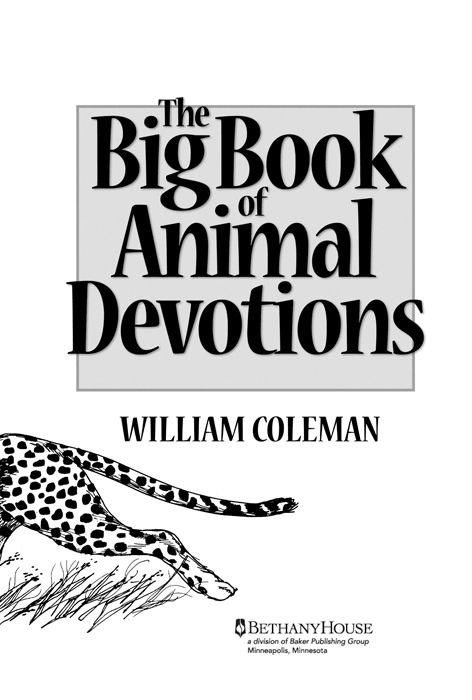
The Big Book of Animal Devotions
Copyright 1979, 1981, 1985, 1987, 2001, 2009
William L. Coleman
Ebook edition created 2012
All rights reserved. No part of this publication may be reproduced, stored in a retrieval system, or transmitted in any form or by any meanselectronic, mechanical, photocopying, recording, or otherwisewithout the prior written permission of the publisher. The only exception is brief quotations in printed reviews.
Published by Bethany House Publishers
11400 Hampshire Avenue South
Bloomington, Minnesota 55438
www.bethanyhouse.com
Bethany House Publishers is a division of
Baker Publishing Group, Grand Rapids, Michigan.
www.bakerpublishinggroup.com
ISBN 978-1-4412-6037-6
Library of Congress Cataloging-in-Publication Data is on file at the Library of Congress, Washington, DC.
Scripture quotations identified ICB are from the International Childrens Bible, New Century Version, copyright 1986, 1988 by Word Publishing, Dallas, Texas 75039. Used by permission.
Scripture quotations identified KJV are from the King James Version of the Bible.
Scripture quotations identified NCV are from The Holy Bible, New Century Version. Copyright 1987, 1988, 1991 by Word Publishing, Dallas, Texas 75039. Used by permission.
Scripture quotations identified NIV are from the HOLY BIBLE, NEW INTERNATIONAL VERSION. Copyright 1973, 1978, 1984 by International Bible Society. Used by permission of Zondervan Publishing House. All rights reserved.
Scripture quotations identified TLB are from The Living Bible 1971 owned by assignment by Illinois Regional Bank N.A. (trustee). Used by permission of Tyndale House Publishers, Inc., Wheaton, IL 60189. All rights reserved.
Cover design by Eric Walljasper
Contents
Dedicated to Ian and Evan
Acknowledgment
Jim Coleman played a big part in putting this book together. His help in research and reading copy are greatly appreciated.
God Made an Amazing World
G od made an octopus that can eat its own arm and grow another one. Some insects sleep for seventeen years and know just when to wake up. A cheetah cat can run seventy miles an hour. These are just a small part of our Creators great imagination.
When Jesus Christ taught, He used fish, lilies, sparrows, and foxes to help us remember. When Paul wrote about anger, he reminded us of the sun. Ezekiel called the pharaoh a bubbling crocodile.
In this book, we use the Bible and nature to teach about God, ourselves, our feelings, and our friends.
Enjoy it and grow.
W ILLIAM L. C OLEMAN
A URORA , N EBRASKA


Main Attraction
W here is the biggest crowd at the zoo? On most Saturday afternoons, people are probably packed around the monkey cage. These cute animals often put on the best fun in any town.
Some of the most popular monkeys in the zoo are rhesus (REE-sus) monkeys. They come from the jungles of India and are in almost no danger of becoming extinct. They are like noisy bees in the wild.
Noisy is the right word to describe them. Rhesus monkeys will jump, fight, argue, chatter, and swing. That is why theres usually a crowd watching them.
They have large families and evidently love to argue with each other. But they dont stay angry. After a string of harsh chatter and some fast action, they calm down and become friends again. In a few minutes they are picking bugs off each other like good buddies.
Most monkeys are afraid of water, but not the rhesus. Give one a small pond and it looks like a champion swimmer.
If you study monkeys closely, you can soon tell one type from another. The proboscis (pra-BOSS-iss) monkey is easy to pick out. Its nose sticks out like a large flat thumb and hangs down to its chin.
The only place proboscis monkeys live is in Borneo, an island in southeast Asia. They dont seem to do well in zoos, so most people wont get to see them.
We are more likely to see spider monkeys. They get their name from their long, thin arms and full tail. The fur makes them look well rounded, but dont be fooled. Underneath they are skinny creatures.
If spider monkeys had their way, they would always stay in the trees. Swinging from limb to limb is their idea of living. Swinging from their tails and picking fruit with their hands and feet keeps them happy all day.
If you are lonely, you might think about buying a howler monkey. Not only do they like to talk, but they do it so loudly you might wonder if the house is falling in. Their sound is something like a car horn. Imagine yourself in a room with this thing going off continuously! Just listening, you might think the howler monkey is being attacked, but he is actually just making a great deal of unnecessary noise.
Sometimes people talk the same way a howler monkey does. We often talk too much. Even worse, we say things that get others upset for nothing. If we say good things about people, talking is helpful, like medicine. But when we merely chatter and dont think, we might really hurt someones feelings.
You are supposed to be a wise man, and yet you give us all this foolish talk. You are nothing but a windbag. It isnt right to speak so foolishly. What good do such words do?
J OB 15:23 ( TLB )

- Which monkey likes to swim?
- Where do spider monkeys like to stay?
- How can we stop from saying cruel things about others?
Guard our lips.
The Pincushion
T he porcupine is not a large animal, but it is feared by some of the biggest. Even a tiger will think twice before tangling with this two-foot-long terror.
Most of the time this prickly pincushion merely minds its own business. But if something wants to start trouble, Pokey will give it a fight.
From its neck to its tail is a heavy coat of quills that look like knitting needles. Each quill is sharp and painful if it sticks you.
Porcupines seem to be slow and helpless. Yet if you attack one, it will turn quickly and try to back into you. It is so fast that it will probably get its attacker by surprise. Sometimes dogs will run at a porcupine, expecting an easy dinner. Pokey will turn, lift its tail, and push its back at the rushing dog. The quills stick into the dogs face and come loose from the porcupine. The dog limps away with a painful howl. Some quills are fifteen inches long and sink deep into the skin. Porcupines cant really shoot their quills like arrows, but they can push their body fast enough to cause serious injury.
A porcupine has thirty thousand quills on its back and sides. Dont try to count them, or Pokey might give a few to you. But that would be no problem since he would quickly grow them back.
A quill is not merely a sharp stick. Each quill has tiny blades all over it. After it goes inside an animal, the quill will push itself deeper and deeper, even after it has left the porcupine. The result is often a nasty wound.
Mountain lions can successfully hunt porcupines, but even they have to be careful to attack only the head or belly.
A coyote that attacks a porcupine may get killed. When a coyote gets a face full of quills, the quills begin to work their way into the coyotes throat and head. It wont be long before the wounded coyote dies.
Next page
